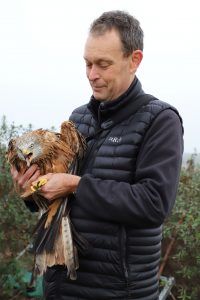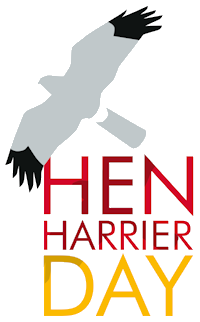Is The Wildlife Management Bill Good News for Scotland's Birds of Prey?

A long-awaited draft bill – The Wildlife Management Bill – has been introduced to the Scottish Parliament’s legislative agenda for debate in the coming months.
It is particularly good news for everyone concerned about raptor persecution, as it proposes a licensing regime for grouse shooting, alongside other legal measures designed to protect wildlife and upland landscapes, including the regulation of all muirburn and tighter controls on the use of traps.
We caught up with Duncan Orr-Ewing, Head of Species & Land Management at RSPB Scotland, to find out more. Duncan has actively campaigned for legislative change and an end to the illegal killing of birds of prey.
HHA: What is your overall reaction to the announcement last week?
We’re very pleased with what the Scottish Government has brought forward, building on the recommendations of the Independent Grouse Moors Group report, the Werrity Review.
The purpose of the Bill, which we strongly agree with, is to give better protection to birds of prey and to stop the illegal killing. The main provisions are to bring in a licensing system for all grouse shooting, and the enforcement of that would be based on a civil burden of proof basis, that is “balance of probabilities”, rather than the current criminal burden of proof.
Up till now, securing convictions based on a criminal burden of proof has been difficult, as often these crimes take place in remote areas with few witnesses, so connecting the crime with an individual can be very difficult.
Another important aspect of the legislation is to extend the licensing regulations to both the area where grouse shooting takes place, and the named and responsible individual. This links to previous vicarious liability legislation which has been in force in Scotland since 2011.
Enforcement of wildlife crimes is always difficult, but it is expected that the Scottish SPCA, which has a team of 70 experienced inspectors, may be given extended powers to help Police Scotland’s network of Wildlife Crime Officers enforce the regulations.
HHA: The Bill bans the use of glue traps and introduces licensing for the use of other wildlife traps. How much impact do you think this will have in protecting wildlife?
Glue traps are not widely used in the UK, but we support the provisions, and more importantly it will bring in tighter regulation and licensing around the use of all traps. We will also be lobbying for the introduction of annual returns on the numbers of grouse shot and counts for so-called “pest” species that are controlled by trapping or other means. This information is vital for the public authority NatureScot to inform sustainable management of both grouse and species killed for the promotion of grouse shooting.
HHA: The proposed introduction of a licensing scheme for grouse moors has attracted criticism from some quarters. Why is this aspect of the Bill so controversial?
We didn’t expect everyone to welcome these proposals, but there have been plenty of warnings that unless the grouse-shooting sector improved their practices, then tighter regulation would follow. As far back as 1998, First Minister Donald Dewar described raptor persecution in Scotland as “a national disgrace”.
I guess that the grouse-shooting lobby is concerned about increased bureaucracy, but every other type of natural resource management, such as tree felling, fishing, or water extraction, is licensed, so I believe that the same standards should apply to gamebird shooting. Most European countries license gamebird shooting and hunting in some way, and the UK has for too long been an exception.
HHA: In an article for The Scotsman in January, you wrote that ‘a strong deterrent and meaningful sanctions are now required’. Do you think the current proposed legislation goes far enough?
Licensing is a civil process, and we believe that the Bill will make it easier to enforce the law in relation to wildlife crime. NatureScot will be the overarching enforcement body for the licensing scheme, informed by intelligence work behind the scenes by Police Scotland and the National Wildlife Crime Unit.
We will be monitoring the Bill’s progress very closely and trying to ensure that any loopholes in the legislation are removed, and that the law is fit for purpose.
HHA: The second part of the Bill strengthens the regulation of muirburn, requiring a licence to carry out burning at any time of the year. Is this a positive step for wildlife?
The current legislation in Scotland for muirburn dates back to 1946, the immediate post-war era, when land was needed to feed a hungry nation. Now the priority is the climate and nature emergency, and we need appropriate legislation to reflect the crisis.
Much of Scotland is covered by peatland soil, which stores a huge amount of carbon, and can be damaged by inappropriate land management. A lot of our peatlands are already seriously degraded, and the Scottish Government is rightly investing £250m over 10 years into restoring peatlands. This public investment should not be compromised.
HHA: What will the RSPB and other organisations be doing now to ensure that the Bill reaches the statute books without being watered down?
I’ve worked for the RSPB for 30 years, and managed the RSPB Investigations team in Scotland and now across the UK for 20 years, and this legislation has been one of our top priorities for a long time, so we want to get it over the line. We want to see it deliver meaningful outcomes and better protection for Scotland’s birds of prey.
HHA: Do you think this Bill represents the beginning of the end for grouse moors, at least in Scotland, or is there still hope for them, if they can respond to change?
I think there is still a future for responsibly and sustainably managed grouse moors. Sustainable grouse shooting, such as walked-up grouse shooting, would have few objections from the RSPB. Our concerns arise with the most intensively managed grouse moors, where the main intention seems to be to deliver very large grouse bags, with damaging consequences for biodiversity and peatlands. We also know that in the last 20 years, the intensity of management on these grouse moors has increased significantly and in many places illegal killing of birds of prey and the scale of burning on peatlands has got much worse.
HHA: Can you foresee a time when this kind of legislation will be adopted across all the countries of the United Kingdom?
Most of the illegal killing of birds of prey associated with gamebird shooting, and especially grouse moor management, are concentrated in Scotland and Northern England. We would hope that a future Westminster Government would look at what happens in Scotland in the next few years and consider introducing similar legislation.
Duncan was instrumental, along with Logan Steele of the Scottish Raptor Study Group and Hen Harrier Action’s own Andrea Hudspeth, in submitting a petition to the Scottish Parliament with over 23,000 signatures, back in 2013, calling for an end to raptor persecution through the introduction of a licensing scheme, which led eventually to the Werritty Review.
